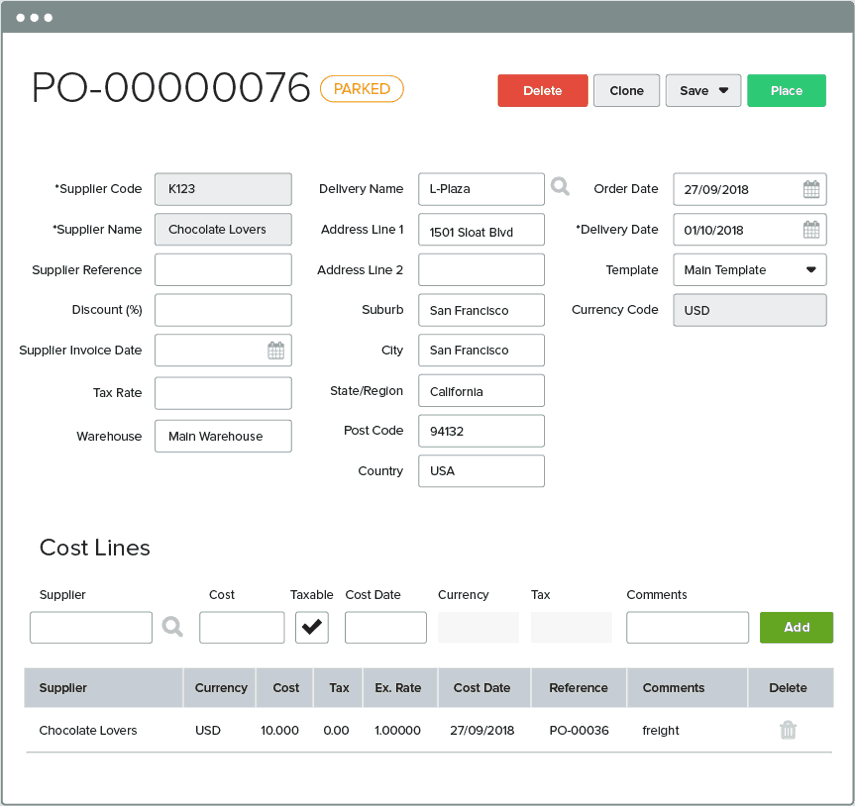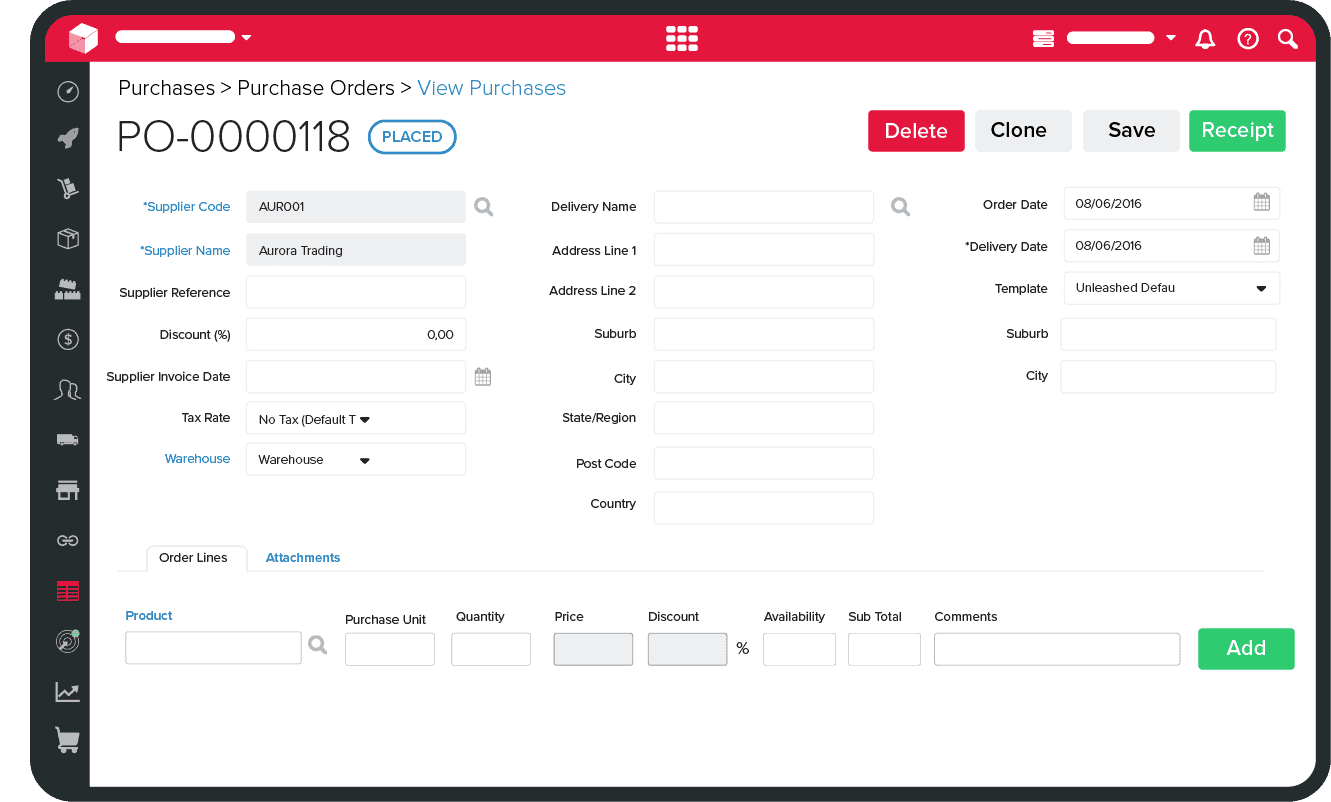If you’re buying or selling goods, you need to know what a purchase order is and how it works. Purchase orders enable easy and safe trading between suppliers and their customers – and provide traceability as ordered items pass through the supply chain.
This article breaks down what a purchase order is, how purchase orders are managed in modern business, and the steps to take to create and raise a PO.
What is a purchase order?
A purchase order (PO) is an official business document sent by a buyer to a seller to authorise a purchase. It lists the items, quantities, and agreed prices of goods the buyer intends to purchase from the seller. A PO may also specify terms for payment and expected timelines for the delivery of the goods.
Purchase orders are legally binding documents that facilitate fair trading between two companies, or between a company and a sole trader.
A purchase order has two primary purposes. It safeguards the buyer from receiving or being charged for the wrong items. And it protects the seller against potential non-payment once the purchaser receives the ordered goods.
 Here's how a typical digital purchase order looks before it is issued to the supplier.
Here's how a typical digital purchase order looks before it is issued to the supplier.
Purchase order vs. invoice
An invoice is a commercial document that itemises and records the products or services a supplier has delivered to a customer. It includes the total amount due, and the preferred payment method.
Invoices are sent to the buyer after purchase orders have been received and fulfilled.
The difference between a purchase order and an invoice:
- A purchase order is issued by the buyer to the supplier for the purchase of goods.
- An invoice is issued by the supplier to the buyer for payment of those goods once the purchase order has been fulfilled.
In short, a purchase order requests goods and an invoice requests payment for those goods.
Purchase order vs. purchase requisition
A purchase requisition is an internal document used to request approval to purchase goods and services. Purchase requisitions outline the individual or department making the request, including the product description, price, quantity, and supplier details.
In most cases, an employee will raise a purchase requisition detailing what needs to be purchased and why. If approved by the procurement team or the financial team, the purchase requisition will be converted to a purchase order and then sent to the supplier.
The difference between a purchase requisition and a purchase order:
- A purchase requisition is an internal document created to seek permission to purchase goods. It is typically approved internally by your financial controller.
- A purchase order is a request to a seller for the purchase of goods.
To summarise: A purchase requisition is an internal request for approval to purchase goods whereas a purchase order is the external request for purchase of those goods from an external supplier.
What is the purpose of a PO?
Businesses can order goods over the phone and informally shake hands over an agreement to buy goods directly from a supplier. You might be wondering, then, what is the purpose of a PO?
The three main reasons for using a purchase order:
- It avoids duplicate orders. You can cross-check POs already in the system to make sure you’re not generating duplicate orders for the same items. A purchase order also enables you to track inventory on order.
- It tracks incoming orders. Purchase orders help you keep track of incoming orders, compare the quantity and description of goods itemised on the PO, and record those items already received against any on backorder.
- It serves as a legal document. A purchase order functions as a legal document, helping avoid any disputes between the purchaser and seller about the order. It settles disagreements over product types, colour, price, quantities, and what was or was not delivered.
How do purchase orders work?
Let’s break down the purchase order management process to get a clearer understanding of how they work.
First, the person in charge of purchasing – often a Buyer or Financial Controller – generates a purchase order expressing exactly what they need from a supplier.
Once the PO has been received, if the supplier has the necessary inventory available to fill the order, the purchase order is accepted and the order is filled and delivered on the agreed due date.
Upon receipt of the ordered goods, the buyer confirms the items delivered correctly match the original PO and then transfers them to the appropriate location and updates their inventory system with the new quantities.
Finally, the vendor sends the buyer an invoice for the purchased items and the buyer pays as per the agreed payment terms.
The purchase order process
The purchase order process is a sequence of actions taken from the purchase request to the receipt of the goods.
A summary of how the purchase order process typically works:
- A buyer generates a purchase order that describes what they need from the supplier.
- The supplier checks to ensure they have the inventory necessary to fill the order.
- The supplier accepts the purchase order.
- The supplier fulfils and dispatches the order.
- The order is delivered with the right goods, in the right quantities, on the agreed date.
- The supplier sends the buyer an invoice for the shipped items.
- The purchaser pays the invoice as per the agreed payment terms.
For large, repetitive, or reoccurring purchases, a buyer may create a standing purchase order allowing them to purchase the same items over and again using the same PO number.
How to raise a purchase order
When a PO is created and issued to a supplier, this process is called ‘raising a purchase order’. How your business operates will determine how you raise a PO.
In a business that uses automated systems – such as inventory management, procurement, or accounting software – it’s possible to raise a PO with minimal manual input.
Purchase orders can be created, auto-populated with key supplier information, and delivered to the customer in just a few minutes. When the ordered goods are received by the purchasing company, they confirm receipt in their system which may also update on-hand inventory levels and accounting records.
In a business that uses manual systems, purchase orders must be created, issued, and reconciled manually. Purchase order templates can help speed up some of the process, but it will still typically take a lot longer to raise a purchase order when compared with using automated purchase order software.
 An example of how to raise a purchase order using purchase management software.
An example of how to raise a purchase order using purchase management software.
Purchase order management
Purchase order management is your business's internal procurement process that ensures all your purchases are necessary and cost-effective.
In larger organisations, there may be an entire purchasing department dedicated to managing purchase orders. In smaller firms, it’s common for a single employee – typically a Buyer, Purchasing Manager, or Procurement Manager – to handle all PO-related tasks.
Two key roles include purchase order processing and operation of purchase order management software.
Purchase order processing
Purchase order processing requires the verification and necessity for goods to be clarified before beginning the purchase progression. It aims to establish a proper flow of a purchase order from its creation through its review, approval, dispatch, and delivery to the payment of invoices and recording of transactions for financial reporting.
Purchase order processing is essential in seasonal procurement or batch-level activity where products are purchased in batches to save on shipping.
Purchase order management software
Purchase order management software simplifies your purchase order process by automatically generating a unique purchase order number for every PO raised. The software provides clear visibility across all purchases made, keeping track of delivery schedules and costs.
PO management software supports better vendor management and supplier relations by making it easier for suppliers to identify what their customers need and when they need it. In addition, the software provides a clear audit trail and helps to improve your inventory forecasts.
Types of purchase orders
Purchase orders come in many shapes and sizes, but most fall under one of five categories.
The five main types of purchase orders are:
- Standard purchase orders
- Blanket purchase orders
- Digital purchase orders
- Planned purchase orders
- Contract purchase orders
Let’s quickly break down each of these common types of PO.
1. Standard purchase order
Standard purchase orders indicate the intent to complete a purchase transaction. Businesses will typically use standard purchase orders for a one-off purchase.
A standard purchase order is created with a complete set of conditions regarding product type, style, price, and quantity. It will usually include clearly defined payment instructions, delivery time, and delivery location.
2. Blanket purchase order
A blanket purchase order is a long-term contract between you and a supplier that represents multiple deliveries of goods over a specified timeframe and at a set price. A blanket purchase order is legally binding once it is accepted by the supplier but should also be an agreed formal contract with the supplier.
The blanket PO expresses the goods and set price that the supplier will provide to you over a specific period. Blanket purchase orders are often established between two businesses with strong B2B partnerships. They may also be associated with buyer discounts or other purchasing incentives.
3. Digital purchase order
A digital purchase order removes the stress of manual procurement processes. Digital purchase orders allow you to raise and manage all your POs from a single location. They reduce the risk of human error and include all the costs associated with purchasing inventory.
Tracking purchase orders is made easier because they are managed electronically. Digital purchasing matches purchase orders to account codes to streamline your spend classification and invoice payments.
4. Planned purchase order
A planned purchase order has more detail than standard purchase orders. They include detailed descriptions of the goods to be purchased.
Based on your previous purchases, you can calculate how much stock you need and create a sequence of purchase orders to release as required. For example, a craft brewer might send out a planned PO when they get down to their last pallet of bottles.
Planned purchase orders are generally used for purchases that are expected to occur on a semi-regular basis.
5. Contract purchase order
Contract purchase orders (CPOs) state an agreed supply of specific products at a specified price, but they’re more flexible than a standard purchase order because they allow for more details.
A CPO contains the usual terms governing payment and delivery conditions and dictates the interval between when POs are issued, and to which supplier. A CPO will also state who is responsible for the payment of additional costs and amendments to the order.

Purchase orders in accounting
Purchase orders follow the same internal accounting process that records and tracks all your transactions. The goods and services on your purchase orders are recorded as purchase transactions in your accounting records.
The process of accounting for purchase orders involves cross-checking and matching the PO with your receipt of goods and the invoice you receive for payment of those goods. A printed PO is often included with the packing slip during fulfilment, making it easier to reconcile items received with the original PO.
In accounting, purchase orders are a liability because they will increase the accounts payable on your balance sheet.
Purchase order journal entries should only be recorded when the supplier has shipped the goods, or once they have been received, subject to the terms and conditions of the PO.
Accurate and approved POs serve as a legal obligation to purchase goods or services. Once a supplier has shipped an order, the accounts receivable account can be debited. When payment has been received from the buyer, the accounts receivable account is credited to match your original journal entry.
Purchase order accounting provides an accurate record of spending and a clear audit trail of purchase transactions. This record helps to quickly resolve any disagreement when a discrepancy or error occurs.
Is a purchase order a contract?
For a purchase order to become a contract, the supplier must accept and agree to the terms of the purchase order by either signing the PO or expressing their acceptance of it in writing.
POs are generally used for short-term purchases, whereas a contract is agreed upon for longer-term purchase arrangements. The offer to purchase goods is not a contract.
Businesses often rely on a separate contract with more detailed terms and conditions about purchasing arrangements, as this can be more effective for reducing risk.
Purchase contracts are long-term arrangements of repeat purchases over time and are legally binding for the entirety of the contract period. They include very specific terms and conditions that offer considerable security against risk.
Is a purchase order legally binding?
A purchase order is a legally binding contract between the buyer and the seller. Purchase orders provide legal protection to the seller if the buyer fails to pay.
However, it only becomes a legally binding agreement when the vendor accepts the order and acknowledges it with a signature or response. At this point, the seller is legally obligated to deliver the goods as per the agreed delivery terms and the purchaser is legally obligated to pay for those items as per the agreed payment terms.
Purchase order financing
Purchase order financing is an arrangement that allows you to access cash before your customers have paid. Using a customer's purchase order as collateral, a third party agrees to give a supplier enough money to fund the customer's purchase order.
PO financing is an effective supply chain management method that helps suppliers fill large orders or meet high demands with little upfront costs. This facilitates a workable debt structure where the third party covers expenses such as their production costs.
Purchase order financing works well for manufacturing and retail organisations with large buyers who rely on their suppliers to outsource goods. However, it is not an ideal solution for service-based businesses or those selling to smaller buyers.
